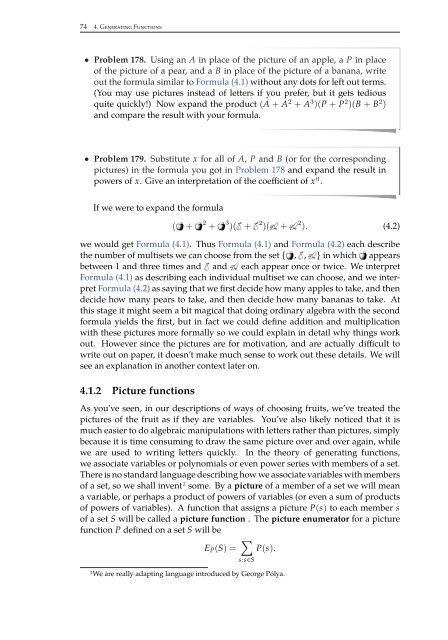Combinatorics Through Guided Discovery, 2004a
Combinatorics Through Guided Discovery, 2004a
Combinatorics Through Guided Discovery, 2004a
You also want an ePaper? Increase the reach of your titles
YUMPU automatically turns print PDFs into web optimized ePapers that Google loves.
74 4. Generating Functions<br />
• Problem 178. Using an A in place of the picture of an apple, a P in place<br />
of the picture of a pear, and a B in place of the picture of a banana, write<br />
out the formula similar to Formula (4.1) without any dots for left out terms.<br />
(You may use pictures instead of letters if you prefer, but it gets tedious<br />
quite quickly!) Now expand the product (A + A 2 + A 3 )(P + P 2 )(B + B 2 )<br />
and compare the result with your formula.<br />
• Problem 179. Substitute x for all of A, P and B (or for the corresponding<br />
pictures) in the formula you got in Problem 178 and expand the result in<br />
powers of x. Give an interpretation of the coefficient of x n .<br />
If we were to expand the formula<br />
( + 2 + 3 )( + 2 )( + 2 ). (4.2)<br />
we would get Formula (4.1). Thus Formula (4.1) and Formula (4.2) each describe<br />
the number of multisets we can choose from the set {, , } in which appears<br />
between 1 and three times and and each appear once or twice. We interpret<br />
Formula (4.1) as describing each individual multiset we can choose, and we interpret<br />
Formula (4.2) as saying that we first decide how many apples to take, and then<br />
decide how many pears to take, and then decide how many bananas to take. At<br />
this stage it might seem a bit magical that doing ordinary algebra with the second<br />
formula yields the first, but in fact we could define addition and multiplication<br />
with these pictures more formally so we could explain in detail why things work<br />
out. However since the pictures are for motivation, and are actually difficult to<br />
write out on paper, it doesn’t make much sense to work out these details. We will<br />
see an explanation in another context later on.<br />
4.1.2 Picture functions<br />
As you’ve seen, in our descriptions of ways of choosing fruits, we’ve treated the<br />
pictures of the fruit as if they are variables. You’ve also likely noticed that it is<br />
much easier to do algebraic manipulations with letters rather than pictures, simply<br />
because it is time consuming to draw the same picture over and over again, while<br />
we are used to writing letters quickly. In the theory of generating functions,<br />
we associate variables or polynomials or even power series with members of a set.<br />
There is no standard language describing how we associate variables with members<br />
of a set, so we shall invent2 some. By a picture of a member of a set we will mean<br />
a variable, or perhaps a product of powers of variables (or even a sum of products<br />
of powers of variables). A function that assigns a picture P(s) to each member s<br />
of a set S will be called a picture function . The picture enumerator for a picture<br />
function P defined on a set S will be<br />
∑<br />
E P (S) = P(s).<br />
s:s∈S<br />
2We are really adapting language introduced by George Pólya.


















